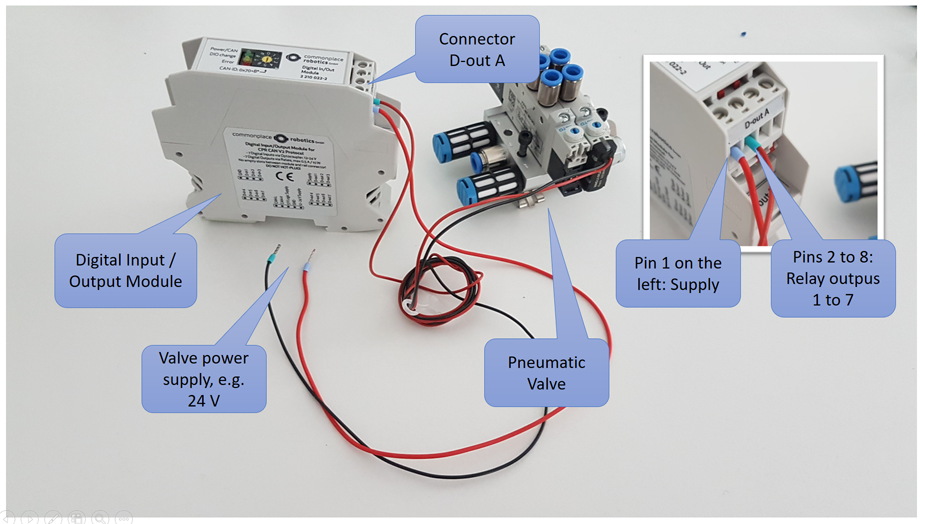Difference between revisions of "Digital Inputs / Outputs"
| Line 1: | Line 1: | ||
| − | Scope: The CPR robolink control comes with a digital input / output module. This page shows how to connect actors, valves or sensors to the module | + | '''Scope:''' The CPR robolink control comes with a digital input / output module. This page shows how to connect actors, valves or sensors to the module |
| − | Description: The Digital IO module provides 7 digital inputs and 7 digital outputs. The inputs are decoupled by optocoupler and accept 24V input signals. The outputs are reed relays which can drive up to 500 mA per channel. | + | '''Description:''' The Digital IO module provides 7 digital inputs and 7 digital outputs. The inputs are decoupled by optocoupler and accept 24V input signals. The outputs are reed relays which can drive up to 500 mA per channel. |
| − | Attention: The outputs must not drive more then 500 mA, also not at startup! Avoid higher currents e.g. due to capaciators! Use a secondary relay in this this case. | + | '''Attention:''' The outputs must not drive more then 500 mA, also not at startup! Avoid higher currents e.g. due to capaciators! Use a secondary relay in this this case. |
| − | Indicators: When the state of a sensor input or and output changes the orange LED on the top is blinking once. | + | '''Indicators:''' When the state of a sensor input or and output changes the orange LED on the top is blinking once. |
The picture below shows an output example: | The picture below shows an output example: | ||
| + | |||
[[File:DIO-Connections.PNG]] | [[File:DIO-Connections.PNG]] | ||
Revision as of 21:35, 20 June 2017
Scope: The CPR robolink control comes with a digital input / output module. This page shows how to connect actors, valves or sensors to the module
Description: The Digital IO module provides 7 digital inputs and 7 digital outputs. The inputs are decoupled by optocoupler and accept 24V input signals. The outputs are reed relays which can drive up to 500 mA per channel.
Attention: The outputs must not drive more then 500 mA, also not at startup! Avoid higher currents e.g. due to capaciators! Use a secondary relay in this this case.
Indicators: When the state of a sensor input or and output changes the orange LED on the top is blinking once.
The picture below shows an output example:
The first pin ( upper left line ) accepts the power supply for all outputs. The other seven lines are the outputs of the reed relays. This means, the relay connects, when switched on, the supply pin (first pin) with the according output pin.
For inputs its the same: the first pin is the ground pin, to be connected with the sensor ground. The sensor signal is connected with one of the seven input pins.
